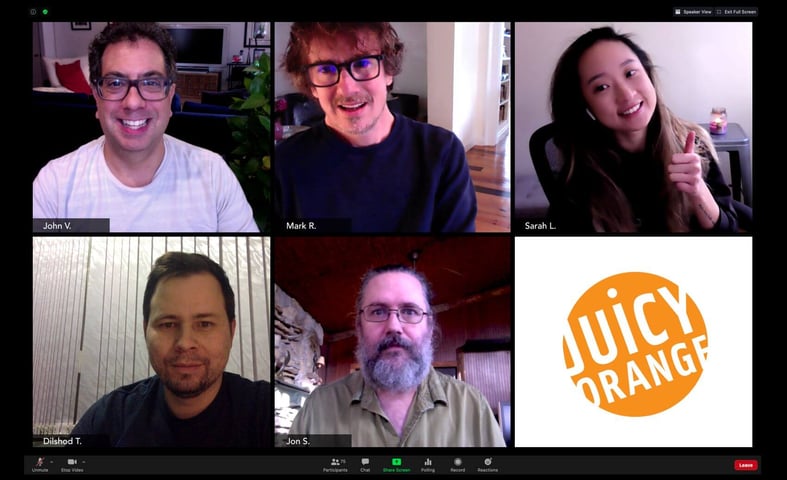Ready to start keeping your projects on track?
Try Harvest free
Web design company Juicyorange was born in the back of a tour bus, in between acid jazz gigs (it was the 1990s). It might be an unusual origin story for a digital agency, but for its founder, drummer-turned-web designer Mark Robohm, it made perfect sense. “The truth about being a touring musician is you only play your instrument for an hour or two a day, the rest of the day you spend traveling and waiting,” he says. That downtime gave him a lot of freedom to cultivate other interests.
“My girlfriend at the time was working for a small newspaper in Burlington, Vermont that needed a website, and so did my band—I didn’t really know what a website was,” he admits, laughing. “And so I thought, ‘Oh, I’ll check that out, I have a computer.’ Not everyone did. And I ended up learning how to do HTML programming and making websites organically.”
From the success of those first two projects, Mark started to make a name for himself as someone who knew how to build websites. He started to pick up more clients, often in shouted conversations over the noise of the venues his band was playing after their shows. Freelancing on the road had its fair share of challenges—like finding reliable dial-up internet to update his clients’ websites in the motels his band stayed at—but over time, Mark’s small web business grew.
Gradually, life milestones like moving to New York City and starting a family turned him from a full-time musician, part-time web designer to a full-time web designer, part-time musician. “My website and music lives are like a mortgage amortization table,” Mark explains. “At the beginning, you pay mostly interest and very little principal. Similarly, at first, I was mostly playing gigs and managing my band’s website. And now I play a few gigs and have a lot of websites to manage.” As his business grew, Mark professionalized—incorporating his company, hiring staff, and eventually taking on a long-time client as a business partner.
Today, they’re a small-but-mighty team that serves a range of clients—from Lärabar and Ariana Grande Fragrances, all the way down to Mark’s dad’s wooden spoon (and electric fence charger repair) business. The diversity of their clientele allows inspiration to flow between projects, sparking innovation. As Mark explains: “We might try a thing on my Dad’s website and then later use a similar idea on the Lärabar website.”
Yet in spite of these successes, Mark was unsure he was really spending his time and energy in the right ways. He wanted external validation. That’s when his architect friend, Josh Fenollosa, recommended he try Harvest.

Keeping himself honest about where his time goes
“There was a moment four or five years ago where I wanted to see how I was actually spending my time because I juggle so many clients,” says Mark. “I’ve always really been good at working in a van and tuning out other band members. I can switch gears very quickly—it’s sort of my superpower. I thought that meant I could manage a lot of tasks efficiently in a day, but I wanted to see if that was true. Sometimes you’re not honest with yourself on how you truly spend your own time.”
He signed up for Harvest and began logging his hours. While his estimation turned out to be pretty spot on—he was managing to service up to 10 or so clients each day—Harvest revealed something even more important: Which projects were making money.
Harvest was a better way of keeping things real, understanding what I was spending time on and whether these jobs were as profitable as I was imagining
them to be.
“Harvest was a better way of keeping things real, understanding what I was spending time on and whether these jobs were as profitable as I was imagining them to be,” Mark says. For instance, certain clients frequently asked the Juicyorange team to integrate a particularly finicky web technology into their websites. At first, they underestimated how much time it would take and drastically under-quoted clients. “We would say, ‘Yeah, we know how to do that. It’s got an API and we’re good at that stuff. We can get it done,’” says Mark. “And then we absolutely hemorrhaged time with it. It took two or three of those jobs in review to see how bad it was. We would never do another fixed bid project with that software again.”
Now, Mark uses Harvest as a retrospective tool. “I definitely track my own time and I’ll look back and say, ‘Dang, that was a busy week.’ It’s also helpful to have this transparency on fixed bid projects. With Harvest, I can run a quick report and see all the time spent, by members, and I’ll realize, ‘Oh yeah, we made good money on that.’ Or, ‘Oh, that was a disaster.’ It’s very good for hindsight assessments.”

Improving transparency with clients
Another one of Mark’s unanticipated benefits from using Harvest is enhanced transparency with his clients. “It’s made me more confident in how I justify our billing to our clients,” he says. “I feel that I can better explain to clients how we are billing them because we granularly track what we’re doing. If a client feels like something should be simple, but have asked to make seventeen tweaks to it over the course of a month, we can clearly show them how these small change requests add up and take time to complete.’”
I feel that I can better explain to clients how we are billing them because we granularly track what
we’re doing.
But it doesn’t just help Juicyorange reduce quibbles over invoices. It helps make all the invisible work that happens behind the scenes visible to clients, proving the team’s value and sustaining important relationships. “The reality is servicing a client takes a lot of time and it isn’t necessarily noticed by the client unless they see it,” says Mark. While his team always over-delivers, their clients don’t know that unless they have some way of seeing it. So, using Harvest, Mark and his team tried a new strategy: showing the client the actual time spent and then offering discounts to meet their promised pricing.
“A lot of times we’ll send clients an actual invoice accounting for our time and then put a significant discount so they can see how we work, ‘Ok, we spent 25 hours on you this month, but we’re only charging you five. We do not bill like lawyers, we’ve got your back,’” says Mark. “I feel like one of the greatest outcomes of using Harvest is justifying how much actual time we’re spending so our clients can see what a value Juicyorange is. We’re a big bang for your buck—we’ll typically bend in the client’s favor to preserve a good client relationship.” And now, Juicyorange’s clients can see that too.
I feel like one of the greatest outcomes of using Harvest is justifying how much actual time we’re spending so our clients can see what a value Juicyorange is.
Marching to the beat of his own drum
Adopting Harvest has helped Mark focus and refine his business priorities. While some companies are hell-bent on growth, Mark is content keeping Juicyorange small and nimble. In the past, Juicyorange has had as many as ten employees—but they’ve since pared down and have found their groove as a tight-knit team. “At the end of the day, we’re a service business,” he says. “With more clients, we had to have more employees to manage them—parallel growth. And then I was just juggling more stuff and getting paid the same amount.”
Using Harvest has made more clear what Mark has known all along: “You don’t need a lot of people to do big jobs, you just need the right, focused people,” he says. “Having a small team almost makes us feel like Navy SEALS at times, as opposed to lines of Redcoats marching with bayonets—we go in tactically, get it done and achieve the same outcome.”
Today, Mark only plays the odd gig here and there, but Harvest ensures that—at least in his web business—he always keeps good time.
Start tracking time today
Join 70,000+ companies spending their time wisely with Harvest.












